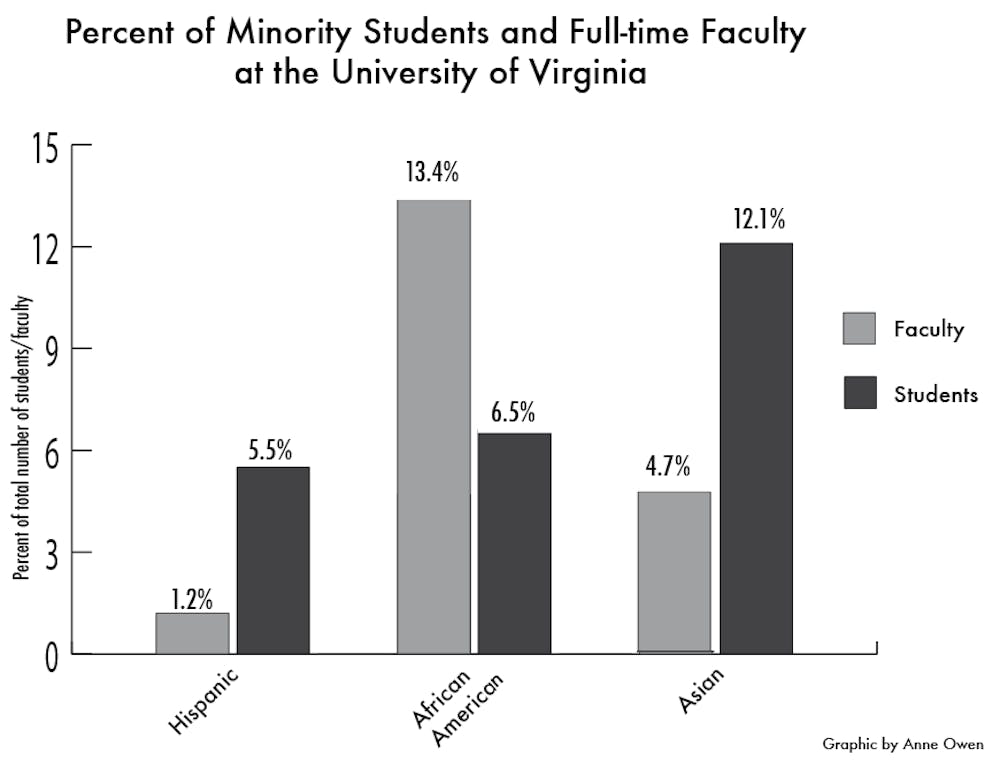Full-time University faculty are less diverse than the student body, according to University data.
Of the 12,159 full-time salaried employees in 2012, 9,428 are classified as white American — making up 77.5 percent of the faculty. The study shows that, of the remaining employees, 1,632 identify as African-American, 574 as Asian American, 149 as Hispanic American, 16 as Native American or Alaskan, seven as Native Hawaiian or Pacific Islander and 52 as multi-racial.
According to 2012-13 demographic data, 28.3 percent of the student body is made up of minority students, compared to 20 percent of faculty. The top three race or ethnic groups represented in the student body are Asians (12.1 percent), African-Americans (6.5 percent) and Hispanics (5.5 percent).
Historical data shows minorities made up 16.7 percent of the faculty in 1979 and 17.4 percent in 2000, showing a 2.6 percent increase in total minority representation since then.
There was a 52.5 percent absolute increase in white American full-time salaried staff between 1979 and 2012. In 1979, the number of white American employees was 6,180, increasing to 8,484 by 2000 and to 9,428 in 2012.
“Of the nearly 40 faculty members in Psychology,
there are five African-American and three
Asian-American faculty members.”
Other racial and ethnic groups saw smaller absolute increases in the past 35 years. The total number of African-American full-time employees was 1,113 in 1979, 1,458 in 2000 and 1,632 in 2012 — a 46 percent increase.
Larger relative gains were seen among other racial and ethnic groups, but absolute gains were still small in comparison. In 1979, the University employed 114 full-time Asian Americans workers, 306 in 2000 and then 574 in 2012. Hispanic Americans went from nine full-time workers in 1979 to 83 in 2000, reaching 149 in 2012.
The demographic breakdown is even more striking within specific departments.
“Of the nearly 40 faculty members in Psychology, there are five African-American and three Asian-American faculty members,” Psychology Prof. Melvin Wilson, who identifies as African-American, said in an email. The other 80 percent of the faculty in the department are white.
Wilson said faculty members of minority background should represent a higher proportion of the University psychology faculty.
However, Commerce Prof. Saonee Sarker, who is Indian, said such low percentages of minority faculty are not the result of conscious decision-making.
“As an African-American in,
a majority white environment,
I never forget or take for
granted who I am and where I am.”
“The number [of minority faculty] is not very high right now — I think it’s more just coincidental,” Sarker said.
Sarker said she is on equal footing with white faculty.
“I don’t see I have an unequal voice in anything,” she said. “I have had equal participation not only in decision-making, but also committee work. I have partnered with white faculty [to teach] in the classroom, and I don’t think I am perceived any differently by the students.”
Wilson, however, said he is more conscious of his race in the working environment.
“As an African-American in a majority white environment, I never forget or take for granted who I am and where I am,” he said. “I am ever-conscious that I am African-American. … I do think my white colleagues have the advantage of not always being reminded that they are white.”







